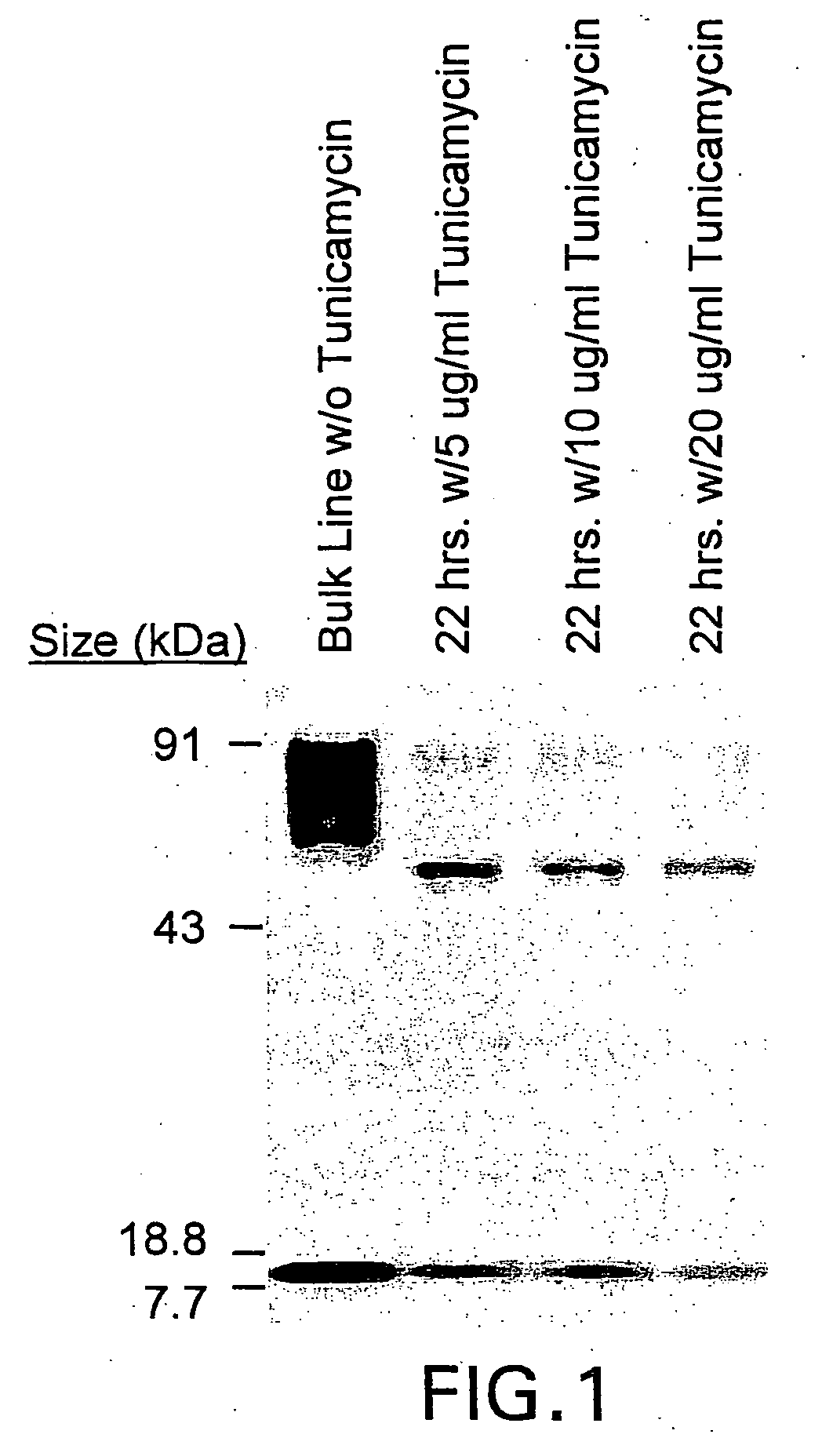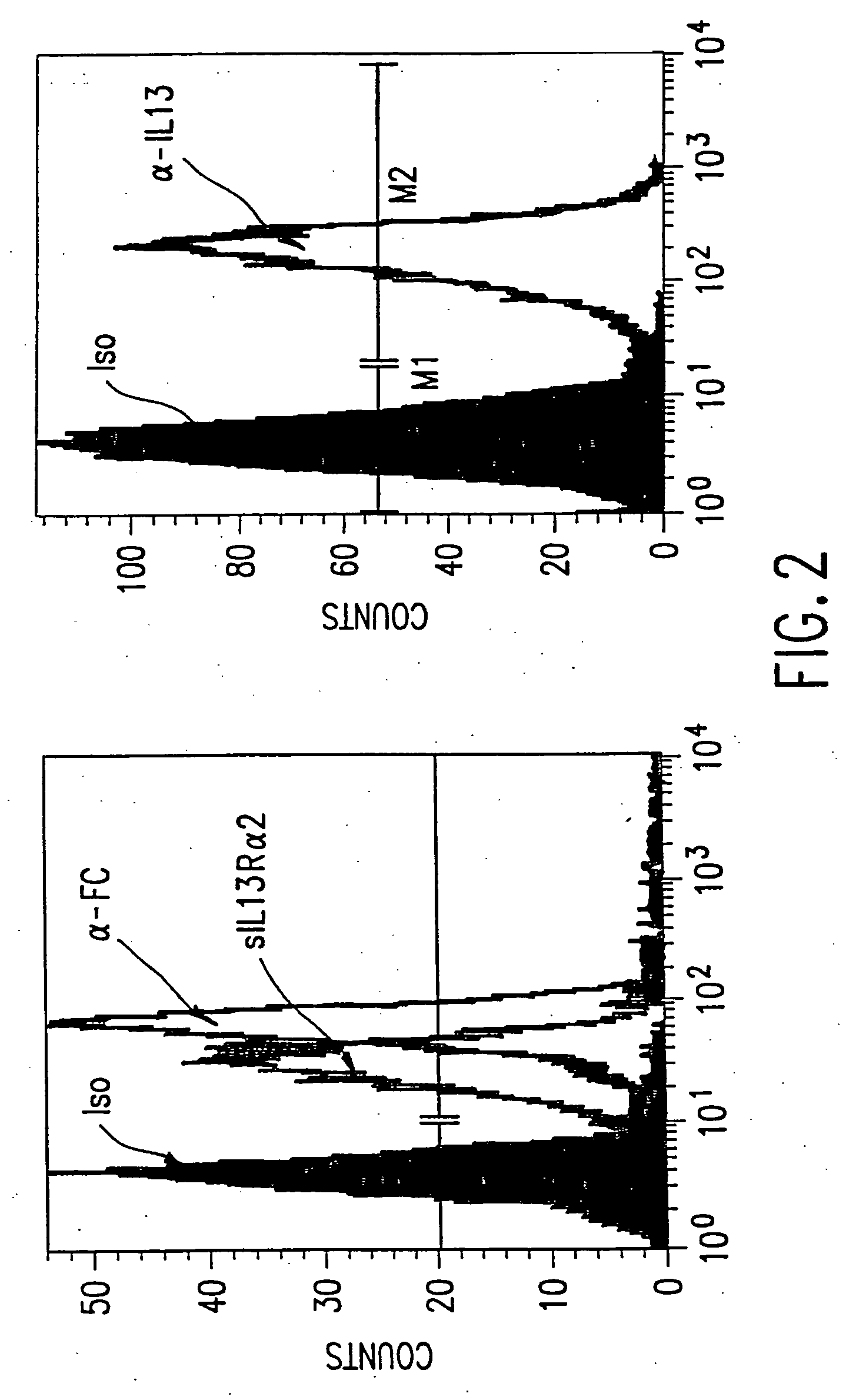Chimeric immunoreceptor useful in treating human cancers
a chimeric immunoreceptor and human cancer technology, applied in the field of cancer therapy, can solve the problems of minimal curative potential of the treatment method, exacerbate the already severe morbidities, and its efficacy, and achieve the effects of negligible toxicity to non-target cells, potent and selectiv
- Summary
- Abstract
- Description
- Claims
- Application Information
AI Technical Summary
Benefits of technology
Problems solved by technology
Method used
Image
Examples
example 1
Construction of an Immunoreceptor Coding Sequence
[0038] The coding sequence for an immunoreceptor according to the present invention was constructed by de novo synthesis of the IL13(E13Y) coding sequence using the following primers (see FIG. 8 for a flow chart showing the construction of the immunoreceptor coding sequence and expression vector):
[SEQ ID NO.1]IL13P1:EcoRITATGAATTCATGGCGCTTTTGTTGACCACGGTCATTGCTCTCACTTGCCTTGGCGGCTTTGCCTCCCCAGGCCCTGTGCCTCCCTCTACAGCCCTCAGGTAC[SEQ ID NO.2]IL13P2:GTTGATGCTCCATACCATGCTGCCATTGCAGAGCGGAGCCTTCTGGTTCTGGGTGATGTTGACCAGCTCCTCAATGAGGTACCTGAGGGCTGTAGAGGGAG[SEQ ID NO.3]1L13P3:CTCTGGGTCTTCTCGATGGCACTGCAGCCTGACACGTTGATCAGGGATTCCAGGGCTGCACAGTACATGCCAGCTGTCAGGTTGATGCTCCATACCATGC[SEQ ID NO.4]IL13P4:CCTCGATTTTGGTGTCTCGGACATGCAAGCTGGAAAACTGCCCAGCTGAGACCTTGTGCGGGCAGAATCCGCTCAGCATCCTCTGGGTCTTCTCGATGGC[SEQ ID NO.5]IL13P5:BamHITCGGATCCTCAGTTGAACCGTCCCTCGCGAAAAAGTTTCTTTAAATGTAAGAGCAGGTCCTTTACAAACTGGGCCACCTCGATTTTGGTGTCTCGG
[0039] The final sequence (417 bp) was...
example 2
Construction of Expression Vector
[0042] An expression vector containing the IL13 zetakine coding sequence was created by digesting the IL13zetakine / pSK of Example 1 with XbaI-NotI, and creating blunt ends with Klenow, and ligating the resulting fragment into the plasmid pMGˆPac (Invirogen) (first prepared by opening with SgrAI, blunting with Klenow, and dephosphorylation with SAP), to yield the plasmid IL13zetakine / pMG. See FIG. 8. The hygromycin resistance region of IL13zetakine / pMG was removed by digestion with NotI-NheI, and replaced by the selection / suicide fusion HyTK, obtained from plasmid CE7R / HyTK-pMG (Jensen, City of Hope) by digestion with NotI-NheI, to create the expression vector IL13zetakine / HyTK-pMG (6785 bp). This plasmid comprises the Human Elongation Factor-1α promoter (hEF1p) at bases 6-549, the IL13zetakine coding sequence at bases 692-2185, the Simian Virus 40 Late polyadenylation signal (Late SV40pAN) at bases 2232-2500, a minimal E. coli origin of replication ...
example 3
Expression of the Immunoreceptor
[0043] Assessment of the integrity of the expressed construct was first delineated by Wester blot probed with an anti-zeta antibody of whole cell lysates derived from Jurkat T cell stable transfectants107 cocultured in the presence or absence of tunicamycin, an inhibitor of glycosylation. FIG. 1. Jurkat T cell stable transfectants (Jurkat-IL13-pMG bulk line) were obtained by electroporating Jurkat T cells with the IL13zetakine / HyTK-pMG expression vector, followed by selection and expansion of positive transfectants. 2×106 cells from the Jurkat-IL13-pMG bulk line were plated per well in a 24-well plate with or without 5 μg / ml, 10 μg / ml, or 20 μg / ml Tunicamycin. The plate was incubated at 37° C. for 22 hrs. Cells were harvested from each well, and each sample was washed with PBS and resuspended in 50 μl RIPA buffer (PBS, 1% NP40, 0.5% sodium deoxycholate, 0.1% SDS) containing 1 tablet / 10 ml Complete Protease Inhibitor Cocktail (Boehringer Mannheim, Ind...
PUM
| Property | Measurement | Unit |
|---|---|---|
| pH | aaaaa | aaaaa |
| concentration | aaaaa | aaaaa |
| concentrations | aaaaa | aaaaa |
Abstract
Description
Claims
Application Information
 Login to View More
Login to View More - R&D
- Intellectual Property
- Life Sciences
- Materials
- Tech Scout
- Unparalleled Data Quality
- Higher Quality Content
- 60% Fewer Hallucinations
Browse by: Latest US Patents, China's latest patents, Technical Efficacy Thesaurus, Application Domain, Technology Topic, Popular Technical Reports.
© 2025 PatSnap. All rights reserved.Legal|Privacy policy|Modern Slavery Act Transparency Statement|Sitemap|About US| Contact US: help@patsnap.com



